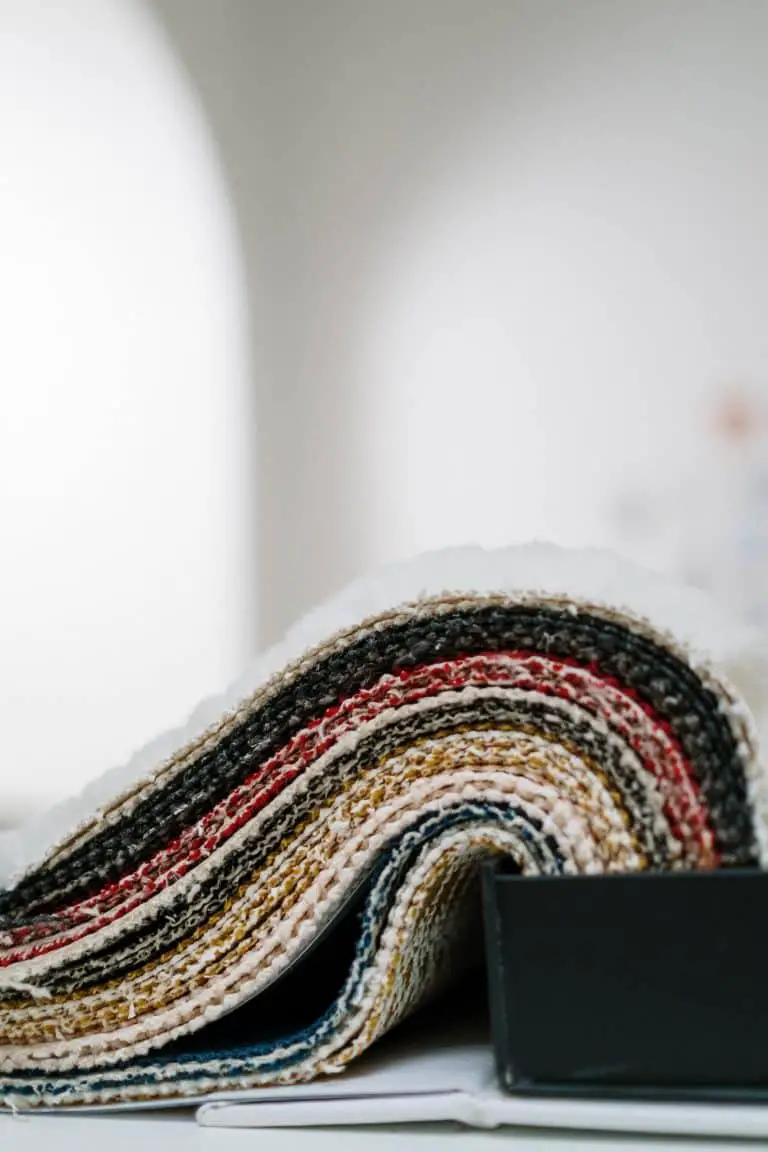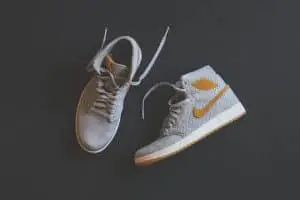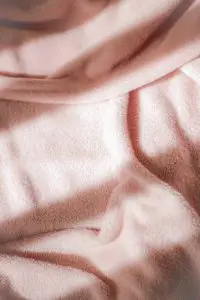Lycra and polyester are amongst the two most popular fabrics in the textile industry today. As a result, most of our apparel today features one of these materials or a blend. This might leave you wondering the difference between the materials and which situation they’re best for. In this lycra vs polyester comparison, you’ll learn everything you need to know about these two textiles. We’ll touch on their uses, what they are, and the different types available. So without further ado, let’s dive in.
Lycra vs Polyester: What is Lycra Fabric?
Lycra is a trademarked name for elastane, a highly elastic synthetic fiber. Although there are different names for this fabric, they’re all the same and refer to a material that can stretch 5-8 times its usual size. Originally, lycra was developed under the DuPont Corporation in the 1950s as a substitute for rubber. However, it wouldn’t exist if polyurethane wasn’t created in the 1930s by IG Farben. Polyurethane is the base material for various plastics, and it contains the same chemical synthesis method used to make lycra.
Like every other polyurethane material out there, lycra is a polymer that features a chain of monomers connected through a type of acid. However, unlike other synthetic fabrics, lycra is resistant to heat and recognized as a great addition to heat-sensitive materials like nylon and polyester. IG Farben created polyurethane, and once he synthesized this substance, he noted its ability to absorb kinetic energy and heat. Dupont’s partnership with German scientists after the war led to the creation of many valuable products, including lycra. Lycra seems to be one of their best innovation due to its extended impact on the economy and consumers’ lifestyles. As a result, lycra is quite popular around the world. Although it seems to influence the environment negatively, it’s unlikely that its popularity will reduce in the foreseeable future.
Lycra vs Polyester: What is Polyester Fabric?
Polyester is a synthetic fiber that comes from a lab, unlike natural fibers from animals and plants. Polyester was invented in 1941 by British scientists James Dickson and John Whinfield. During World War II, they created this fabric for developing parachutes and other war materials. However, it soon made its way into the consumer market. Polyester was a big business opportunity in the US after Dupont bought the rights to create polyester.
Polyester is created using a chemical reaction that utilizes petroleum, water, coal, and air in a high-pressure and temperature-controlled vacuum. This process is called polymerization and transforms melted plastic into polyester fibers. When mixed, it creates a compound called a monomer. To make polyester, manufacturers use 70 million barrels of oil each year.
This chemical process results in a long-fiber polymer material that is then stretched until it is about five times its initial length. The stretching process makes the fabric quite strong and ensures its durability. To create the fibers used in apparel production, threads of the polyester are then spun together either on their own or blended with another fabric. Polyester came into full popularity in the 1960s and birthed the printed t-shirt style in the 1970s. Today, polyester is available everywhere, from apparel to home furnishing.
Lycra vs Polyester: Uses of Lycra
Different consumer fabrics feature lycra today. This fabric owes its popularity in the textile industry to its stretchability. However, it is pretty rare to find apparels that only use lycra in its production. Typically, most manufacturers blend lycra with other fabrics to increase its stretch. When blended with cotton, wool, or polyester, these materials become stretchier. The elasticity added to the fabric usually depends on the amount of lycra added to the other fabric. For example, adding 10% of lycra to a non-expandable fabric can expand the material to twice its size.
Most times, manufacturers use lycra in the production of shape-fitting outfits. Therefore, you can find it in men’s and women’s underwear. Lycra features in apparel that come in close contact with the skin. It is also present in boxer briefs for men even though they’re lost. It usually appears in the waistband to make them tighter in the abdominal area.
Underwear is not the only garment where you can find lycra. It is also present in loungewear, sweatpants, and many other garments. You can tell when a garment features lycra by its stretchiness. For example, the socks didn’t feature lycra; it would be difficult to wear and remove them because of the absence of elasticity.
Lycra is also a popular fabric in sportswear. Almost all types of sporting gears feature some percentage of lycra. It is common in hiking, swimming, or biking clothing because they need to be close to the skin. The presence of lycra makes it tight and comfortable at the same time.
Lycra vs Polyester: Uses of Polyester
There are different polyester uses in the fashion industry because of its popularity. Polyester can take different forms because of its various manufacturing process. It can resemble linen, silk, cotton, or wool. When you blend this fabric with other textiles in the industry, it takes on even more forms and combines its unique qualities with that of the other fiber. Below are the common uses of polyester in the consumer market today.
Apparel Uses
Polyester is common in the production of various apparel. Unlike lycra in this lycra vs polyester comparison, it is common to use polyester on its own. However, it also features in blends. Polyester is common for making all types of clothing, from casual to formal wear. A common mix is a cotton and polyester; it is common for making t-shirts. A polyester and wool blend is also common for suits and other formal wear.
Additionally, it combines its durability and easy maintenance with the comfort of these natural fibers. You can also find polyester fiber inside most apparel. An example is most ski jackets created today. Manufacturers use hollow polyester fabrics between the lining and exterior fabric to ensure warmth while wearing the fabric.
Home Furnishings
Whether on its own or as a blend, polyester is a common fabric in creating upholstery, curtains, draperies, carpets, wall coverings, and many more. A common reason why manufacturers use polyester or blend with cotton is to mitigate the wrinkling feature of cotton. When blended with cotton, it eliminates the need for ironing, although it reduces the comfortability of the fabric. Instead of nylon, manufacturers use polyester to create affordable carpets for consumers. However, such carpets easily wear than when manufacturers utilize nylon. Carpets made from 100% polyester also feature a high build-up of static electricity during the dry winter months.
Bags and Backpacks
It is also a common material in creating tote bags, workout bags, and many more because of its moisture resistance, affordability, and durability.
Lycra vs Polyester: Types of Lycra
To learn everything you need to know in this lycra vs polyester comparison, below are the different types of lycra available in the consumer market.
Cotton Lycra
This type of lycra is common in the production of shrink-free shirts and tops. However, if you’re looking to create durable and wrinkle-free apparel, you should mix cotton and lycra. Many clothes come from this blend. It is easy to maintain, and there’s no need to worry about stains in this lycra blend. Therefore, cotton lycra is an excellent option for clothes.
Nylon Lycra
Another popular option is nylon lycra, and it is a common choice in the production of table covers, bags, couch covers, handbags, and many more. It is a famous choice because of its durability. Although these fabrics feature a little shine because of the blended materials, they usually last for many years. You can see the shine in this blend when it comes in contact with light. Additionally, manufacturers use this blend because of its smoothness and draping feature. It is also as effortless to maintain as cotton lycra and lightweight. When used in the creation of evening wear, nylon lycra gives the appearance of elegance and classiness.
Wool Lycra
This is a common choice in the production of coats and suits; this is ideal for this kind of formal wear because it keeps the wearer warm and prevents shrinking. The lycra’s stretchiness prevents the shrinkage of wool in these outfits. Additionally, wool makes these apparel rigid, while lycra ensures an excellent fit for the wearer. Lycra provides the apparel structure featuring this blend a perfect fit to improve its appearance.
Lycra vs Polyester: Types of Polyester
Just like lycra in this lycra vs polyester comparison, it is crucial to know the different types of polyester fabrics available to further your knowledge of this fabric. There are three major types of polyester available, and below, you’ll find a breakdown of each fabric.
Ethylene Polyester
This type of polyester is the most common option available. It is also known as PET, so most people think it is the only polyester fabric available. PET and polyester are used interchangeably in the consumer market, despite the availability of other polyester variations.
Plant-Based Polyester
A common issue with polyester and other synthetic materials is non-biodegradable. However, that’s not the case with this plant-based polyester. Its main advantage lies in the fact that it is biodegradable. This is because it is created using plants, unlike other forms of polyester. However, it features a longer processing time and costs more to produce. Plant-based polyester is also less durable than other types of polyester available.
PCDT Polyester
The last type of polyester available is the PCDT polyester. It isn’t as popular as the other types of polyester. However, it has its unique features. This type of polyester offers more elasticity than other types of polyester. This makes it ideal for many apparels and other products in the consumer market. It is also a more durable option; therefore, manufacturers utilize it to produce heavy-duty products.
A Great Online Class: Color Theory for Textile Projects by Domestika
If you are interested in learning more about how you can create a successful name for your business, we recommend taking a look at the online class “Color Theory for Textile Projects”.
The course is currently under promotion, but you can use the discount code: T_BROWNLEES-PROMO to get an additional 10% discount on your purchase.
This online class offered by Domestika, at a very inexpensive price covers all you need to know to develop your textile project by leveraging color theory to create the perfect color palette. If you apply to the course through the link below you’ll be supporting 440 Industries, and we thank you for it!
Final Thoughts
Polyester and lycra are two popular fabrics common in creating clothes and other items in the consumer market. However, most people know quite little about these two fabrics and the proper use of them. This article seeks to provide insight and what they are, their primary uses, and the different types. This lycra vs polyester comparison provides you with everything you need to know about the fabrics to determine the best option for you.








